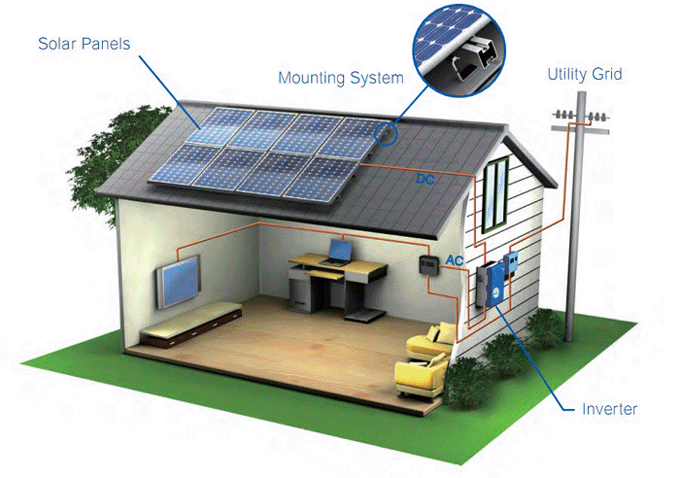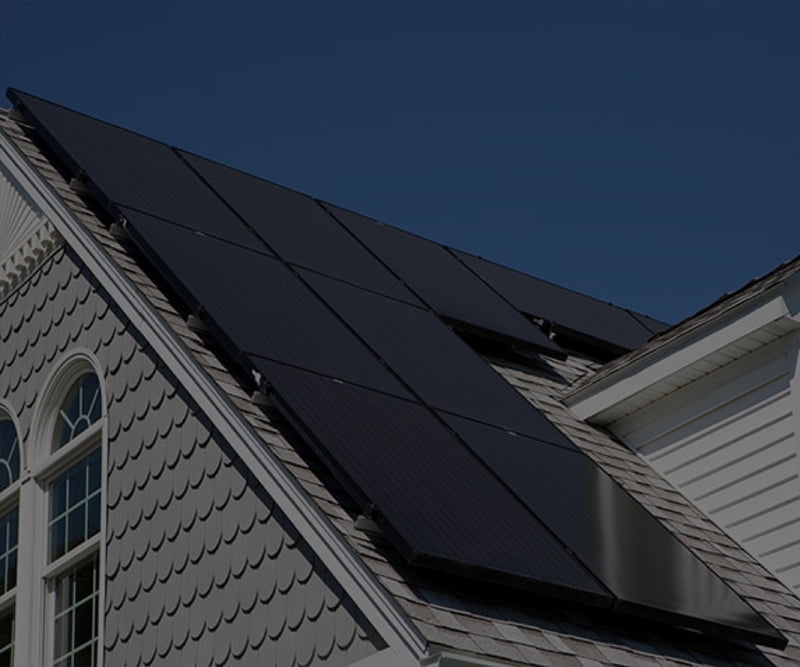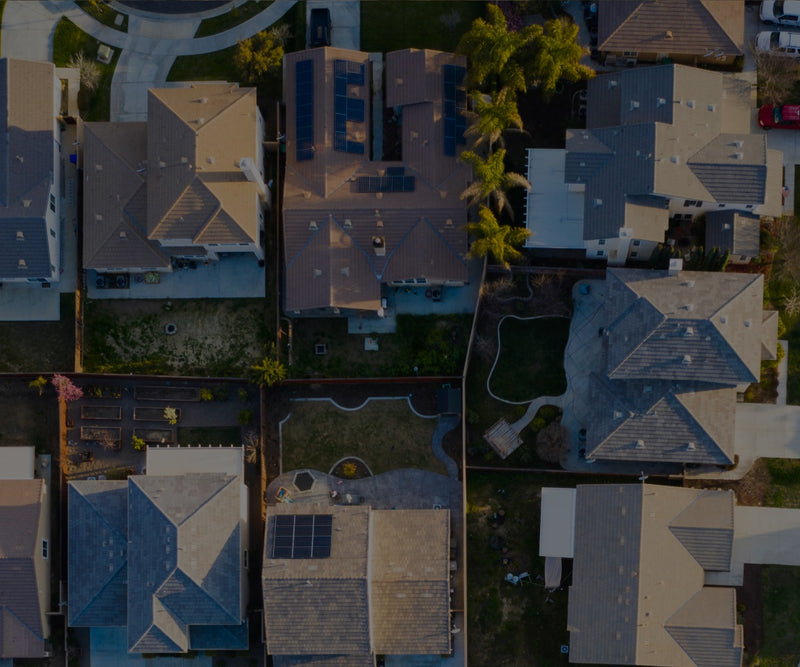Solar Components: What's in a Solar Power System?

What are the components of a solar power system?
The main solar components that come with every solar power system or solar panel kit are:
- Solar panels
- Inverters
- Racking (mounting system)
- Batteries
But how do these solar system components convert the sun’s energy into usable electricity for your home or business? On this page, we’ll break down all the solar system components and explain how they work.
Solar Panels

Solar panels convert sunlight into electricity through a process called the photovoltaic effect. During this process, solar panels collect electrons from the sun’s light in the form of direct current (DC) electricity, which then pass through the inverter to convert into usable AC electricity (more on that below).
Individual panels are made of up several solar cells, which are silicon wafers that are wired together and held in place by the backsheet, frame, and a pane of glass.
A panel string is a group of — typically 4-10 — panels wired together in series, which then plugs into an input on a string inverter.
Your solar array refers to all the panels that make up your system. An array may contain one or more panel strings wired into a string inverter or any number of panels individually paired with microinverters.
When you’re browsing solar panels, you’ll come across two types: monocrystalline or polycrystalline, and two different sizes.
Find out What Is a Half-Cut Solar Panel
Monocrystalline vs. Polycrystalline
Monocrystalline (mono) solar panels contain solar cells which are cut from a single source of silicon.
Polycrystalline (poly) solar panels are created by melting smaller silicon fragments and blending them to create solar cells. The blended nature of poly cells makes them slightly less efficient than mono cells, which means mono panels allow you to fit more solar in a smaller space.
While mono panels used to carry a higher price tag due to their increased efficiency, that is no longer the case. As companies have geared their production lines to focus on mono panels, more efficient manufacturing processes have brought the cost of mono and poly panels right in line with each other. Mono cells now represent about 75% of the panels on the market.
In terms of aesthetics, poly cells give solar panels their signature blue hue, while mono panels have a more sleek and modern all-black look to them.
Learn more about Monocrystalline vs Polycrystalline Solar Panels
60/120-Cell vs 72/144-Cell
Full-sized solar panels come in two standardized sizes:
60-cell and 120-cell panels are about 40” by 66”, give or take an inch depending on the manufacturer. 60-cell panels contain 10 rows of 6 cells each. 120-cell panels are the same size and configuration, but the cells are cut in half, which boosts panel efficiency slightly.
72-cell and 144-cell panels are about 40” by 78”, again with small variations depending on the manufacturer. 72-cell panels contain 12 rows of 6 cells each. 144-cell panels are the same form factor, but with half-cut cells.
Larger solar panels are about a foot taller and 8 pounds heavier, which can make them a bit harder to carry during installation, especially if you are installing a system on your roof. Regardless, it should be easily doable with 2+ people assisting the installation.
Larger panels can be slightly more cost-effective, however, your choice often comes down to whichever one will fit best on your rooftop. If you have a tall roof, you may be able to fit two rows of 60-cell panels, whereas a smaller roof may need 72-cell panels to fit as much solar as possible into a limited space.
These are the most common sizes in the industry, but there are other less common sizes and form factors. Smaller panels are more portable, making them a viable option for mobile applications like a boat or RV system.
Learn more about 60-cell vs. 72-cell Solar Panels: What’s the Difference?
What to look for in solar panels?
Here are a few considerations to keep in mind while you’re shopping for solar panels or solar panel kits:
- Cost per watt: Panels come in all sizes. Divide the panel price by its wattage rating to compare the cost of solar panels on a level playing field.
- Efficiency rating: High-efficiency panels are great if you have limited space to work with.
- Warranty period and terms: Higher-quality panels will retain more of their production capacity over time. Look for the "degradation rate" in the performance warranty.
Browse The Best Reseidential Solar Panels for 2022
Inverters

Inverters are the brains of a solar power system. They are responsible for converting DC power (from your panels) into AC power (the format that is usable by your household appliances). They also route the flow of electricity between system components, and most provide a monitoring solution to track your system’s performance.
There are a few types of inverters to choose from:
- String inverters
- String inverters with PV optimizers
- Microinverters
- Storage-ready inverters
String Inverters
A string inverter is a central unit with inputs for strings (groups) of solar panels. In string inverter systems, solar panels are chained together in series, with the final panel in the chain plugging into an input on the inverter.
For example, this sample 8 kw kit is designed with two strings of 10 panels apiece, for a total of 20 panels.
String inverters are the most cost-effective option when your system is built-in full sunlight. However, shading presents problems for string inverters. When one panel in a string is shaded, its output drops, and the rest of the string drops to match the reduced output of the shaded panel.
If your build site is blocked by trees, chimneys, or other obstructions, a string inverter alone won’t be enough to get the most out of your solar array. In those scenarios, you’ll want to add PV optimizers to mitigate the impact of shading.
String Inverters + PV Optimizers
A PV optimizer is a small device that attaches to the back of each panel. The optimizer isolates the output of each panel, allowing it to produce power (and report back to your monitoring system) independently from the rest of the panels in your array.
That means that if a panel is covered in shade, only that panel will be affected. The rest of the array will continue to perform at its full capabilities.
PV optimizers also allow for individual panel-level monitoring. You’ll be able to see how each panel is performing in your monitoring portal. If a panel is underperforming, that may be a sign that it needs to be cleaned or replaced. (In pure string inverter systems, monitoring only reports the performance of the system as a whole, and you’d have to test them one by one to identify the issue.)
Microinverters
Like PV optimizers, microinverters attach to the back of each panel to optimize the system’s output and allow for individual panel-level monitoring.
Unlike optimizers, microinverters do not need a centralized string inverter unit to tie the system together. Instead, the inverting capabilities are handled by the microinverter unit itself.
That means that each microinverter + panel pairing is like a mini self-contained solar power system. You no longer have to worry about sizing panel strings to match a string inverter’s power limitations.
The result is that microinverter system design is much more flexible, modular, and expandable than string inverter systems:
- Start small and expand your system later; no retrofitting or re-installation needed
- For oddly-shaped roofs, place panels on different roof facings without needing to string panels together
- Repair or replace individual panels or microinverter units without taking the whole system out of commission
While microinverters are more costly up front, they have a longer warranty period that makes them a better value over the life of the system. String inverters are typically warrantied for 5-15 years and often require replacement in the middle of your system’s lifespan. In contrast, Enphase’s IQ7 series microinverters are warrantied for 25 years to match the length of most solar panel warranties.
Learn How to Install Solar Inverters
Storage-ready inverters
By default, grid-tie inverters like the SMA Sunny Boy are not equipped with battery charging capabilities. If you decide to add energy storage to your system, be sure to look for an inverter that facilitates battery charging. These are often referred to as “storage-ready” or “hybrid” inverters.
If you want to add storage to a microinverter system, the Enphase Ensemble package is a good choice. It combines Enphase’s microinverters, batteries, and monitoring into a streamlined system. With all-native Enphase components, it was designed with compatibility and ease of installation in mind.
Another option is the Sol-Ark all-in-one hybrid inverter, which combines functions like inverting, charging, and monitoring into a single unit. This reduces the number of components to make installation even easier, but the tradeoff is that it is less flexible and expandable than Enphase’s modular system.
Racking

Racking is the foundational structure that secures your solar panels in place. Racking systems come with mounting rails and flashings to secure the rails to your rooftop or ground mount.
The majority of home solar systems fall into one of two categories:
We'll also cover a few unique racking solutions with more niche applications, like pole mounts and ballasted mounts.
Roof Mount Racking
Roof mounts make use of your home’s rafters to support the weight of the solar array.
For roof-mounted systems, you’ll need a way to locate and mark your roof rafters, so that you can drill holes into the rafters and bolt the flashings in place. If your rafters aren’t visible under the edge of your roof, you can use a stud finder to locate them or measure their position from the inside of your attic.
Roof mount systems are the standard choice for most home solar installations, as they are the most convenient and cost-effective option available. Putting panels on your roof saves valuable space, which is crucial if you have limited yard space and can’t fit a ground mount on your property.
If you have a viable South, West, or East facing roof with enough space to build your array, a roof mount is usually the most cost-effective option.
Ground Mount Racking
A ground mount is a standalone support structure built out of metal pipes that are securely set into concrete footings in the ground. Ground mounts take more time and money to install, given that you will be building a new structure to support the solar array.
Ground mounts offer greater flexibility with the orientation of your array. You can point the panels directly toward the Equator and tilt them at the perfect angle to maximize the system’s output. With roof mounts, you’re locked into the tilt angle and facing of your rooftop.
Ground mounts are also easier to access for routine cleaning and maintenance. With a ground mount, you won’t need to climb on your roof to clean the dust off the face of your panels.
Commercial and rural properties are especially suited to ground mount systems, as they often have plenty of space to build an array that takes advantage of the full capacity of their solar panels.
Pole Mounts
A pole mount is a type of ground mount that elevates solar panels high off the ground on a tall pole. They are useful in a few scenarios:
Pole mounts can tilt panels at a steeper angle, using the force of gravity to shed snow off the face of the panels. They can also be adjusted to lift the array higher in the air, providing clearance over snowbanks that accumulate in the winter months.
Steep hillsides prevent challenges for standard ground mount systems, which use several distributed concrete footings to anchor the mount in place. It can be tough to dig deep enough trenches to pour the concrete and level off the mount on a steep slope. Pole mounts only require one anchor point, which makes it much simpler to install them on a steep hillside.
Ballasted Racking
A ballasted racking solution is a container with a frame that allows you to mount your solar panels. The container is filled with ballast, a heavy material such as dirt or gravel, which provides enough weight to hold the system in place.
Because ballasted mounting systems rely on counterweights to hold the system in place, there is no need to dig holes and pour concrete to anchor the mount into the ground. As a result, ballasted systems are cheaper, easier and quicker to install.
Learn more about the PowerRack ballasted mounting system.
Solar Power Batteries

In off-grid and battery backup systems, a local battery bank is necessary to store usable energy on-site. This is helpful in the event of grid failure, extreme weather, or other interruptions.
There are three types of batteries that you can use with your solar power system:
- Flooded lead-acid batteries
- Sealed lead-acid batteries
- Lithium batteries
Learn more on How to Choose a Solar Battery Backup System for Your Home
Flooded Lead-Acid Batteries
Flooded lead-acid (FLA) batteries are sometimes referred to as "wet cell" batteries because the electrolyte is in liquid form and can be accessed by removing the battery caps.
Charging flooded batteries causes water in the electrolyte solution to evaporate, so they regularly need to be refilled with distilled water to keep them topped off. This need for routine maintenance means flooded batteries are only suitable for those who have the time (and the desire) to perform maintenance checks on their battery bank on a monthly basis.
FLA batteries are especially prone to failure if not properly maintained, and we find that most people can't (or won't) commit to the monthly maintenance schedule needed to properly care for FLA batteries.
Their strict maintenance requirements means they are not suitable for vacation homes, nor would we recommend them for full-time off-grid residences, unless you really love the idea of getting hands-on with your system. However, committed homesteaders and DIYers may find FLA batteries to be a cost-effective option, so long as they take excellent care of the battery bank.
Sealed Lead-Acid Batteries
Sealed lead-acid (SLA) batteries get their name because the compartment containing the electrolyte is sealed, which prevents leaks and noxious fumes coming from the battery.
Unlike flooded lead-acid (FLA) batteries, sealed batteries have minimal maintenance requirements and do not need to be installed in a ventilated battery enclosure. SLA batteries can also be mounted in any orientation because the contents of the battery are sealed shut.
There are two sealed lead acid battery types: absorbent glass mat (AGM) and gel batteries.
AGM batteries are less expensive and perform better than gel batteries in cold temperatures. They are also capable of higher charge and discharge rates. They are the more cost-effective sealed battery option, recommended in most off-grid solar applications.
Gel batteries are an older technology that cost more than AGM batteries. They take longer to charge and are not as widely available as AGM. Gel batteries do perform better in high ambient temperatures, so they may make sense in hot climates, but AGM is usually the more cost-effective option.
Lithium Batteries
Lithium batteries tend to be about 3x the cost of SLA batteries, but they also last about 3x longer, so the higher initial cost balances out over the life of the system.
If you want a high-performance battery that you don’t have to replace for a decade, lithium batteries are the most convenient option. They have faster discharge and recharge rates, weigh less, and are maintenance-free. In addition, lithium batteries are modular, meaning you can start small and expand your battery bank as needed.
While lithium batteries cost more upfront, the cost falls in line with lead-acid batteries over the life of ownership.

Solar Calculator

Which Solar Kit Do I Need?
GET STARTED WITH SOLAR
WE’LL HELP YOU FIGURE OUT YOUR SOLAR NEEDS!
Fill out the form for a complimentary solar quote that includes a custom satellite layout, system design and a breakdown of total project cost and estimated savings.
